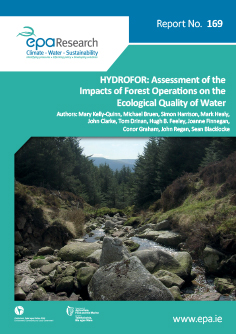Research 169: HYDROFOR: Assessment of the Impacts of Forest Operations on the Ecological Quality of Water
Authors: Mary Kelly-Quinn, Michael Bruen, Simon Harrison, Mark Healy, John Clarke, Tom Drinan, Hugh B. Feeley, Joanne Finnegan, Conor Graham, John Regan, Sean Blacklocke
Summary: HYDROFOR is an EPA and DAFM-supported multi-sector co-operative project to investigate the impacts of forestry operations on Ireland's aquatic ecology.

Identifying Pressures
Implementation of the Water Framework Directive (WFD) requires identification and quantification of anthropogenic pressures on water resources and the implementation of Programmes of Measures (POMs) to prevent further deterioration in water quality and achieve least good status for all waters. The 2005 “National Characterisation Report for Ireland” produced during the first WFD management cycle, identified forestry as one of the land-use activities posing potential risk in terms of diffuse pollution due to increased acidification from conifer plantations in acid-sensitive catchments, sedimentation from clear felling, harvesting, new plantations, road construction and erosion on steep catchments, and eutrophication from fertilisation on steep catchments and forest harvesting on peat soils. The Hydrofor project identified windrowing as an additional potential source of sediment and nutrients in streams. The potential for impact depends on the magnitude ofthe pressure and susceptibility of the pathway as well as the sensitivity of the receptor.
Informing Policy
The Water Framework Directive is the key EU legislation requiring Member States to improve and sustainably manage and protect water resources. The research presented in this report will inform forest policy review, environmental considerations in the development of forestry programmes, the refinement of forest and water quality guidelines, and guidance on best practice in relation to forest operations aimed at reducing pollutant inputs. The latter is especially relevant in the development of measures to protect endangered species such as the pearl mussel. The research also has relevance to water quality monitoring and reporting by theEnvironmental Protection Agency and overall land-use planning.
Developing Solutions
Solutions to water quality problems must be underpinned by sound knowledge of the sources and drivers of pollution and the pathways that deliver pollutants to water courses. Hydrofor addressed several key information needs by investigating pollutant inputs from forest operations through the entire forest cycle. The key drivers of the episodic acidity were shown to be organic acidity together with base cation dilution. Higher losses of organic acidity from forests planted on peat were highlighted as a concern. Elevated sediment andphosphorus release to water courses was detected during felling, windrowing and replanting. A small numberof potential mitigation measures (aquatic buffer zones and sediment traps) to address these problems were investigated in this study and the research evidence highlighted their ability to reduce some pollutant inputs. For example sediment pollution may be reduced by careful onsite management of felling and windrowing operations, installation of silt traps and greater application and oversight of best practice guidelines. Mitigation of phosphorus inputs is more challenging on peat soils and depends on the presence of mineral content inriparian soils or installation of mineral barriers.
https://www.epa.ie/media/epa-2020/publications/research/EPA-RR-169_20mm[1].jpg